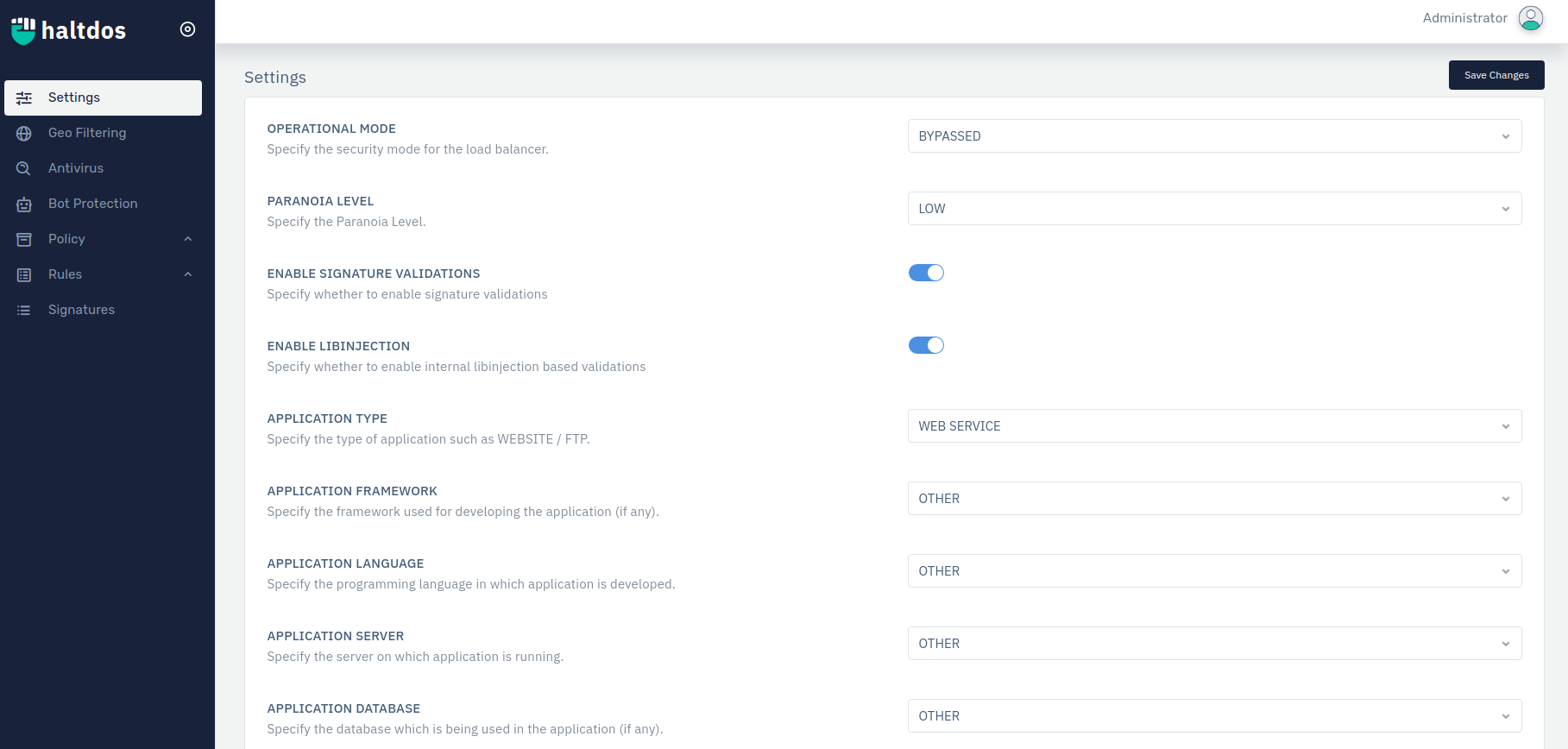Settings
Overview
Profile Setting specifies all the operational settings for user different application type (i.e. WEBSITE/WEB SERVICE/WEB SOCKET). It provides user protection and invokes signature rules to every configured specific settings for mentioned application type.

How to Use:
- Go to WAF > Listener > Security Profiles > Settings.
- Configure your settings.
- Click on Save Changes.

| Parameters | Accepted Values | Default |
|---|---|---|
| Operational Mode | Drop-Down | Bypass |
| Paranoia Level | Drop-Down | Low |
| Enable Signature Validation | Boolean | False |
| Enable LibInjection | Boolean | False |
| Application Type | Drop-Down | Other |
| Application Framewwork | Drop-Down | Other |
| Application Language | Drop-Down | Other |
| Application Server | Drop-Down | Other |
| Application Database | Drop-Down | Other |
| Application OS | Drop-Down | Other |
| User Groups | Drop-down | Blank |
| Temporary Blacklist Duration | Integer | 0 |
Description
1.Operational Mode: This option allows user to specify operational mode for every given security profile. Different operational modes are:
-
MITIGATION: In this mode, all the mitigations & rule sets will monitor the traffic. If any request matches the criteria, it gets dropped
-
BYPASS: In this mode, all the requests get bypassed without any filtration of mitigations & rule sets.
-
RECORD: In this mode, all the mitigations & rule sets will monitor the traffic. If any request is about to drop, then it gets captured and forwarded in the form of a Record Event.
2.Paranoia Level: Paranoia level configures the severity in which HTTP requests should be allowed. It lets you disable certain rules to minimize several false positives that they may encounter.
Note: Higher paranoia can also result in false positives.
Haltdos WAF comes with four Security Paranoia Levels:
-
LOW -Adequate security level to defend almost all web applications from generic exploits. Recommended security level to ensure the least disruption from false positives.
-
MEDIUM - A slightly higher level of security to block nearly all web application exploits. It might result in some false positives.
-
HIGH - A more paranoid approach to web security. It delivers a higher number of false positives.
-
UNDER ATACK - The most paranoid defensive security method. It blocks sufficient legitimate requests to your site.
3.Enable Signature Validation: Users can specify to enable the signature validation for the present profile.
4.Enable LibInjection: Users can configure settings related to Specify whether to enable internal libinjection based validations.
5.Application Type: Specify the type of application ( i.e. website or web service). A website is a collection of linked web pages (plus their associated resources) that share a unique domain name. A web service is a collection of open protocols and standards used for exchanging data between applications or systems.
6.Application Framework: Specify the framework used for developing the application (if any).
7.Application Language: Specify the programming language in which application is developed.
8.Application Server: Specify the server on which application is running.
9.Application Database Specify the database which is being used in the application (if any).
10.Application OS: Specify the Operating system on which application is running.
11.User Groups: Create a user group for operating the API gateway. Detailed information can be found using this link User Group.
12.Temporary Blacklist Duration: The time duration for which a malicious IP is suspended by WAF is specified here. The WAF Rules and Web Policy use this value.